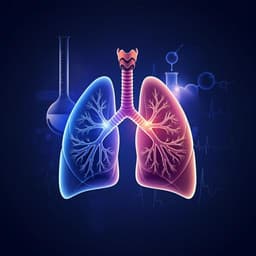
Health and Fitness
Training caretakers to clean community wells is a highly cost-effective way to reduce exposure to coliform bacteria
M. A. Habib, S. Cocciolo, et al.
This groundbreaking study by Md. Ahasan Habib, Serena Cocciolo, Md. Mir Abu Raihan, Prosun Bhattacharya, and Anna Tompsett reveals that training community well caretakers significantly reduces water contamination in Bangladesh, offering a cost-effective solution to prevent child deaths from waterborne diseases.
~3 min • Beginner • English
Introduction
A quarter of the world’s population lacks reliable access to safe drinking water, contributing to a large global burden of deaths and disability-adjusted life years (DALYs) due to inadequate water, sanitation, and hygiene (WASH). The current rate of progress toward universal access to safely managed drinking water (SDG target by 2030) is far too slow globally and especially in fragile contexts. In Bangladesh, progress must accelerate markedly to meet the SDG target. A central obstacle is drinking water quality: use of “improved” sources does not guarantee safe water, and many households collect contaminated water despite using improved infrastructure. In Bangladesh, bacterial contamination is common even in tubewells classified as improved sources. Further improvements to infrastructure are costly and do not necessarily eliminate fecal contamination; maintenance challenges persist; and chlorination approaches require ongoing supply. The study investigates whether improving well cleaning practices—a neglected aspect of water provision—can cost-effectively improve water quality. Evidence suggests contamination can be introduced at the tubewell mouth and accumulate as biofilms, implying that better cleaning could reduce contamination. The research question is whether training community well caretakers to clean wells more effectively improves water quality and at what cost-effectiveness.
Literature Review
Prior literature has given scant attention to routine cleaning practices of wells, with policy recommendations largely focused on emergency remediation. Some studies document water quality improvements when external staff clean wells. In the study area, a pilot found that scrubbing and rinsing interior surfaces with a weak, low-cost chlorine solution improved water quality when trained staff performed the cleaning. However, typical caretaker practice focused on external surfaces and platforms, showing no improvement in water quality, leaving open whether unpaid community caretakers could adopt more effective protocols.
Methodology
Design: A randomized experiment was conducted to estimate the causal effect of training community well caretakers in improved cleaning protocols. Caretakers were randomly assigned to be offered a training workshop (with or without supplies) or to a control group without training. Randomization ensures treated and control wells are observationally equivalent, isolating the effect of training from temporal changes (e.g., weather).
Intervention: A single 2.5-hour training workshop was delivered in December 2021 to caretakers of community deep tubewells (installed 2015–2017) in communities of 50–250 households in North-Eastern Bangladesh. Some caretakers were also assigned to receive cleaning supplies (including bleach powder for chlorine solution) in addition to training.
Study setting and wells: Deep tubewells (drawing from aquifers ~100–250 m deep) installed on adequately drained sites at sufficient distances from contamination sources. Community placement involved consensus meetings with representation of women and the poor. Each well had one male and one female caretaker selected by consensus among self-identified users after installation.
Data collection timeline: Endline water quality and survey data were collected approximately 13 months (January 2023) and 17 months (May 2023) after training.
Caretaker surveys: Enumerators interviewed caretakers jointly about well condition and recommended activities and individually about knowledge and practices regarding cleaning protocols, and experiences with the training (first endline). Interviews were conducted in Bangla, in caretakers’ homes.
Water quality testing: At each round, field staff collected one 100 mL water sample per well without pre-pumping to reflect typical drinking water contamination. Sodium thiosulfate-containing sterile vessels were used; samples were stored cleanly, processed within ~5 hours. IDEXX Colilert-18 and Quanti-Tray/2000 were used to measure total coliforms and E. coli. Trays were incubated at 35 °C for 18 hours; large and small positive compartments were counted, and Most Probable Number (MPN) per 100 mL generated. Samples were tracked with anonymized QR barcodes. No blanks were collected; manufacturer QC tests could not be used due to lacking a reliable setup.
Attrition/functionality: Only functional wells (sufficient water volume for sampling) could be tested. Between baseline functionality (June–July 2021) and January 2023, five wells ceased functioning (3 control, 2 training+supplies). Between January and May 2023, an additional six wells ceased functioning (3 control, 2 training+supplies, 1 training-only). Some pairwise differences in functionality rates are statistically detectable at the 10% level, but given multiple tests, differences may be due to chance.
Caretaker characteristics: Using pre-existing household survey data, a random forest classification approach compared households with and without caretakers, accounting for sampling weights and distances to wells; summaries provided in supplementary figures.
Statistical analysis: Outcomes were regressed on treatment indicators (assigned to training arms versus control). Standard errors were clustered (reported as clustered by well or household where applicable), with robust SEs and p-values reported for contaminant presence outcomes (Fig. 3). Analyses considered linear treatment effects and applied weights so each well counts equally in certain caretaker knowledge/practice analyses.
Cost-effectiveness analysis: For water quality improvements, the mean reduction in the presence of total coliforms averaged 28.2 percentage points across 13 and 17 months. Median users per well across rounds averaged 23.5 households, with 3.9 members per household, implying approximately 25.9 people per treated well avoid exposure to coliforms. Program costs imply US$0.89 per person protected. For potential health impacts, meta-analytic estimates of mortality reduction from water treatment (24%) were applied across under-five age groups using rural Bangladesh mortality rates and local household demographics. Effects were assumed to persist 17 months then decay linearly over the next 17 months (total equivalent 25.5 months). DALYs per under-five death were assigned per WHO guidelines.
Key Findings
- Water quality impacts (13–17 months post-training):
• E. coli contamination: Trained wells had negligible contamination rates (13 months: 2%; 17 months: 4%) versus control wells (13 months: 14%; 17 months: 19%). Reported p-values in related panels indicate statistical significance at conventional levels in several comparisons (e.g., p ≈ 0.04 at 13 months; p ≈ 0.019 at 17 months in specific specifications).
• Total coliform contamination: At 13 months, control 55% vs trained 3%; at 17 months, control 77% vs trained 46%. Several comparisons were statistically significant (e.g., p = 0.028 at 13 months; p = 0.005 and p = 0.022 at 17 months in specific panels).
- Caretaker knowledge and practice:
• At 13 months: Training+supplies vs training-only: average elements recalled 2.0 vs 1.0; elements regularly practiced 1.6 vs 0.0. Differences were larger for elements requiring chlorine solution.
• At 17 months: Training+supplies vs training-only: average elements recalled 4.0 vs 0.6; elements regularly practiced 0.7 vs 0.3. Regular practice of chlorine-solution steps declined, likely due to supply exhaustion; only seven wells had bleach powder in stock (five in training+supplies), and only two wells reported caretakers purchasing bleach themselves (dose cost ≈ US$0.045).
• Reported barriers: At 13 months, lack of time; at 17 months, need for new solution stock/resources.
- User access/behavior: No statistically significant differences in number of users between treated and control wells at 13 or 17 months, suggesting reduced contamination was not driven by restricting access.
- Cost-effectiveness (water quality): Average reduction in coliform presence 28.2 percentage points; approximately 25.9 people per treated well avoid exposure. Estimated cost ≈ US$0.89 per person protected.
- Cost-effectiveness (health impacts): Modeling suggests one child death averted per approximately 104 wells treated. Cost per life saved estimated at US$2376–US$3276 depending on specification; cost per DALY averted ≈ US$29 (≈US$21 in 2010 international dollars). Estimated DALYs averted per well ≈ 70.8 (based on program costing for trainings+supplies).
Discussion
Training community well caretakers to follow an improved cleaning protocol substantially reduced microbial contamination of drinking water. Thirteen to seventeen months after a single 2.5-hour training, E. coli contamination was nearly eliminated and coliform contamination roughly halved relative to control wells. Providing supplies alongside training enhanced recall and adherence to chlorine-based steps compared to training alone, although some effects persisted with training alone, suggesting modest behavior changes can yield large water quality gains. The intervention appears highly cost-effective: under conservative modeling assumptions, the cost per DALY averted (~US$29) is around 1% of GDP per capita and well below common willingness-to-pay thresholds, rendering the program comparable to leading child health interventions. Compared to chlorination programs that require ongoing inputs, a one-off training may induce durable behavior changes with persistent impacts. Potential mechanisms include improved cleaning of internal well components and greater user awareness to avoid introducing contamination. Scaling could lower delivery costs further via economies of scale and closer-to-home training logistics. The study underscores that focusing on maintenance and cleaning practices within existing infrastructure can be a powerful, low-cost pathway to safer drinking water, complementing more capital-intensive approaches.
Conclusion
The study demonstrates that training caretakers to clean community deep tubewells more effectively can dramatically reduce E. coli contamination and substantially reduce total coliform contamination for at least 17 months post-intervention. Providing supplies improves adherence to chlorine-based cleaning steps, but even modest uptake of improved practices can yield large water quality benefits. Modeled health benefits suggest the intervention is highly cost-effective, with low cost per DALY averted and competitive with top global child health interventions. Future research should: (1) directly measure long-run health outcomes and persistence beyond 17 months; (2) optimize and simplify cleaning protocols to maximize impact while minimizing time and financial burdens for unpaid caretakers; (3) examine effectiveness across different well types (e.g., shallower wells, non-professionally installed wells) and trainee populations; and (4) evaluate scalable delivery models and integration with existing WASH programs.
Limitations
- Outcomes measured focus on water quality; long-term health impacts were modeled, not directly observed.
- Study timeframe limits inference on durability beyond 17 months; assumed linear decay thereafter may misstate persistence.
- Some caretakers received training remotely; heterogeneity in training delivery and caretaker engagement could affect results.
- Generalizability may be limited: results pertain to deep, professionally installed tubewells in specific Bangladeshi communities; effects may differ for other well types or contexts.
- Participants and staff were not blinded to treatment status; however, laboratory water quality tests were anonymized, mitigating measurement bias.
- Water quality QA/QC: No blanks were collected; manufacturer quality control procedures could not be implemented due to setup limitations.
- Attrition due to non-functional wells occurred between rounds; although differences across arms may be due to chance, they could affect comparability.
- Statistical analysis descriptions note clustered standard errors and linear effects; some reporting ambiguities (e.g., clustering unit) may limit replication without consulting replication code and supplements.
Related Publications
Explore these studies to deepen your understanding of the subject.







